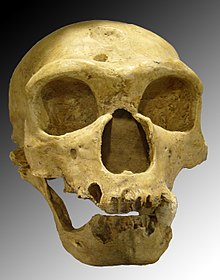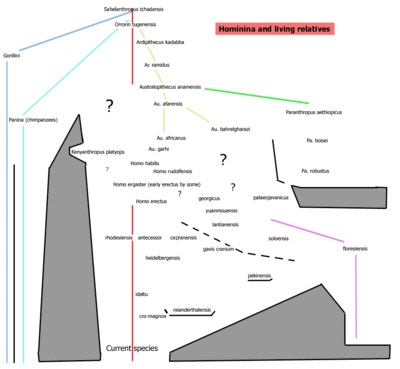This is an old revision of this page, as edited by AndriyK (talk | contribs) at 20:36, 7 December 2008 (→Description: Replacing some very special terms by more common words). The present address (URL) is a permanent link to this revision, which may differ significantly from the current revision.
Revision as of 20:36, 7 December 2008 by AndriyK (talk | contribs) (→Description: Replacing some very special terms by more common words)(diff) ← Previous revision | Latest revision (diff) | Newer revision → (diff)
| Hominina | |
|---|---|

| |
| Skull of Homo neanderthalensis | |
| Scientific classification | |
| Kingdom: | Animalia |
| Phylum: | Chordata |
| Class: | Mammalia |
| Order: | Primates |
| Superfamily: | Hominoidea |
| Family: | Hominidae |
| Subfamily: | Homininae |
| Tribe: | Hominini |
| Subtribe: | Hominina |
| Genera | |
| |
The more anthropomorphic primates of the Hominini tribe are placed in the Hominina subtribe. They are characterized by the evolution of an increasingly erect bipedal locomotion. The only extant species is Homo sapiens. Fossil records indicate this subtribe branched from the common ancestor with the chimpanzee lineage about 3 to 5 million years ago.
Taxonomy
Current evidence suggests that, about 2.6 million years ago, Australopithecus began to diverge into two paths, on the one hand to Paranthropus, more robust, specialized in an herbivorous diet that required a stronger jaw and molars and powerful facial muscles that required a cranial crest, much like a modern gorilla has, to unite them. The other track led to Homo with a relatively larger brain, more delicate teeth and jaw. Both genera existed at the same time for about a million and a half years.
This subtribe is usually considered to include Australopithecus, Paranthropus, Sahelanthropus, Orrorin, Ardipithecus, Kenyanthropus, and Homo. However, the exact makeup is still under debate, as some scientists struggle to determine the order of descent in human evolution.
Description
Key features of this group involve various adaptations for living predominantly on the ground rather than on the trees. In particular, it is vertical standing, moving on two legs and the skull placed on top of the vertebral column. The feet are not prehensile unlike the rest of primates, since the first toe is built robustly and aligned with the other four. The hands have a developed opposable thumb and are quite adept at manipulating objects.

| Apes | ||
|---|---|---|
| Extant ape species |
| |
| Study of apes | ||
| Legal and social status | ||
| Related |
| |